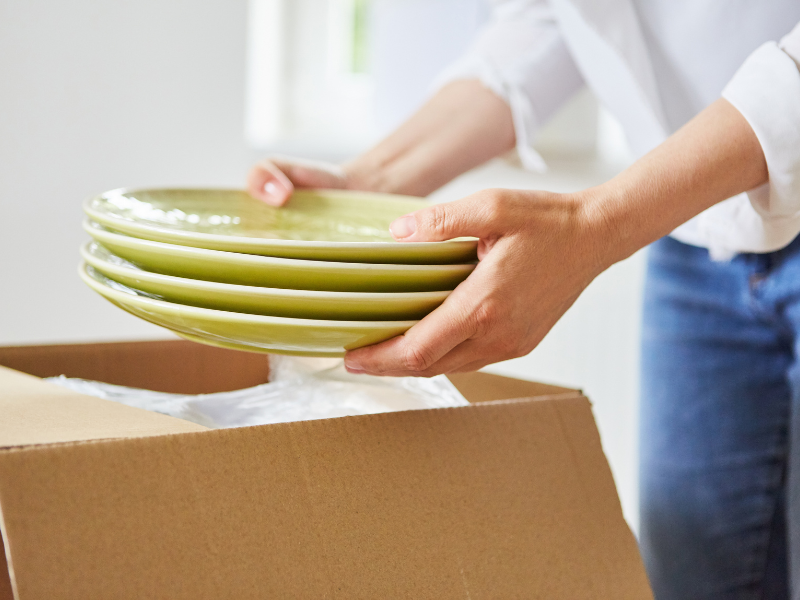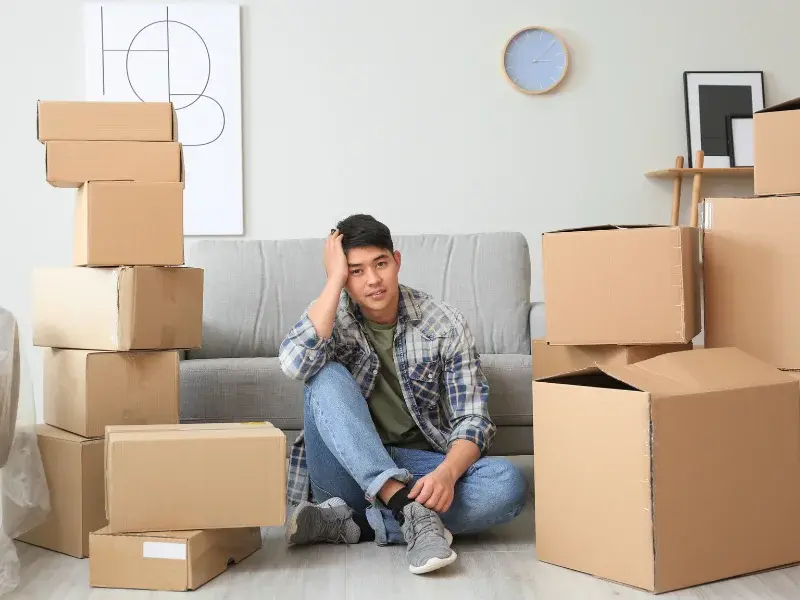The professional movers at DMAX have received specialized training in packing methods and techniques to ensure that your items remain intact during the move.
We are excited to present our packing tips and tricks!
Discover our recommendations for properly packing your belongings.
Packing Tips #1: Declutter and Lighten Your Boxes
Moving is the perfect opportunity to sort through your belongings. Here’s how to declutter and pack optimally:
Sort Your Items Room by Room
Go into each room of your house and review all the items. Categorize them into three groups: to keep, to donate/sell, and to throw away. This method will help you better organize your move and reduce the number of boxes needed.
Donate Unused Items
For items in good condition that you no longer need, consider donating them to a local charity center.
Clothes, books, toys, and small furniture can be very useful to others.
Pack these items in bags or boxes and clearly label them to avoid any confusion during the move.
Sell Valuable Items
Some items you no longer wish to keep may have value. Sell them online on platforms like eBay or Facebook Marketplace. You could also organize a garage sale. The proceeds can help cover part of the moving expenses.
Dispose or Recycle Damaged Items
Broken, damaged, or used items should be properly disposed of. Take them to the dump or recycling center.
This will help you get rid of unnecessary clutter and free up space for the items you really want to move.
Use Alternative Containers
To save on packing materials, use items you already own. Suitcases, laundry baskets, storage bins, and bags can be used to pack your items.
For example:
- Pack your clothes in suitcases.
- Use laundry baskets to transport bathroom or kitchen items.
- Place heavy items in sturdy storage bins.
- Protect dishes and fragile items by wrapping them in newspaper or bubble wrap before placing them in boxes.

Packing Tips #2: Use Quality Materials for Your Packing
Purchase Quality Materials
Packing materials such as boxes, bubble wrap, plastic wrap, and tape can represent a significant expense. However, cheap boxes tear easily and can damage your valuable items. If you're not sure where to get them, find out where to buy quality moving boxes near you.
Therefore, opt for sturdy boxes that will better protect your belongings, even if it costs a bit more.
If you're unsure how many you'll need, check out our guide on how to estimate the number of moving boxes required.
Use Materials Sparingly
While purchasing quality materials is important, it is wise to use them economically. Reserve bubble wrap for particularly fragile objects and use newspaper for less delicate items.
Similarly, use plastic wrap strategically to fill empty spaces in boxes and protect items from shocks.
Economical Alternatives
If your budget is limited, consider alternatives to obtain packing materials. Here are some ideas:
- Borrow Boxes : Ask friends, family, or neighbors if they have boxes to lend. Use social networks to make requests. You might be surprised at how many people are looking to get rid of their packing boxes after a move.
- Retrieve Boxes from Stores : Many stores discard their boxes after deliveries, especially during imports.
Visit supermarkets, retail stores, or shopping centers and ask if they have boxes available.
This method allows you to obtain boxes often still in good condition for free.
Packing Tips #3: Use Towels and Sheets
Wrap Fragile Items with Sheets
Protect your items by wrapping them in sheets. This method offers double protection by cushioning shocks and preventing scratches.
Additionally, sheets can be used to cover large items like mirrors and paintings, adding an extra layer of protection.
Distribute Weight by Mixing Items
To avoid overloading moving boxes and facilitate transport, mix items in your boxes.
For example, place books, knick-knacks, and other small items in a box, then add sweaters around them. This creates natural padding and distributes the weight evenly.
This way, the items do not collide and remain stable in the moving truck.
Optimize the Use of Items
- Towels and blankets : Use them to wrap anything bulky or to protect furniture corners.
- Pillows and cushions : Perfect for cushioning shocks in large boxes or for filling empty spaces in the truck.
- Curtains and rugs : Wrap them around fragile items or use them as a base in boxes to add a layer of protection.
Packing Tips #4: Use Wrapping Paper and Bubble Wrap
Bubble wrap is ideal for protecting breakable items. Use this material to wrap the most fragile objects, such as wine or champagne glasses, and porcelain tea cups.
By carefully wrapping each item in bubble wrap, you add a layer of protection that absorbs shocks.
Wrapping paper is also an excellent protector for items. Use paper to wrap everyday glassware, coffee cups, and other small items.
For plates and dishes, layer sheets of paper between each piece. This reduces the risk of breakage by preventing the items from colliding during transport.
Packing Tips #5: Use Colored Tape to Seal Boxes
Using Colored Tape
A simple but effective method to organize your moving boxes is to use colored tape. By sealing each box with a specific color, you can easily identify its contents and fragility level.
Description and Implementation
- Choice of Colors : Choose different colors for each type of item.
For example:
- Red : Fragile items like dishes, glasses, and mirrors.
- Green : Clothing and textiles.
- Blue : Documents, binders, important papers.
- Yellow : Non-breakable kitchen items.
- Orange : Toys and children's items.
- Application : Seal each box with the corresponding color tape after filling it. Make sure the tape is clearly visible on the top and sides of the box for easy identification.
- Additional Labeling : For even more precise organization, add a label with a description of the box next to the colored tape. Also, indicate the destination of each box, such as "Bedroom", "Garage", "Kitchen", "Living Room", etc.
Reasons and Benefits
- Quick Identification : Colored tape allows for immediate identification of the box, which directly facilitates the movers' work and yours during unpacking.
- Fragility Management : By using red tape for fragile items, you signal to the movers which boxes need to be handled with extra care.
- Visual Organization : The color code provides a clear and neat visual organization. This is particularly useful during the loading and unloading phases of the moving truck.
- Time-Saving : This system reduces the time spent searching for specific items after the move, as you know exactly where to look based on the color of the tape.
What Not to Pack During a Move?
Hazardous Products
- Flammable Products : Items such as paints, solvents, gasoline, lighters, matches, and propane bottles are extremely dangerous and should not be transported in boxes.
- Reason : These products can ignite or explode, endangering the safety of your belongings and people.
- Chemical Products: Household cleaners, pesticides, fertilizers, and other chemical products can cause leaks and dangerous reactions.
- Reason : These substances can be toxic and corrosive, posing health risks and potentially damaging other items.
Valuable Items
- Jewelry, cash, important documents : Do not put your valuable items in boxes.
- Reason : These items are better kept with you to avoid the risk of loss or theft. This includes passports, birth certificates, contracts, and other sensitive documents.
- Expensive Electronics : If possible, carry valuable small electronic devices yourself.
- Reason : To reduce the risk of damage and theft.




Post a comment